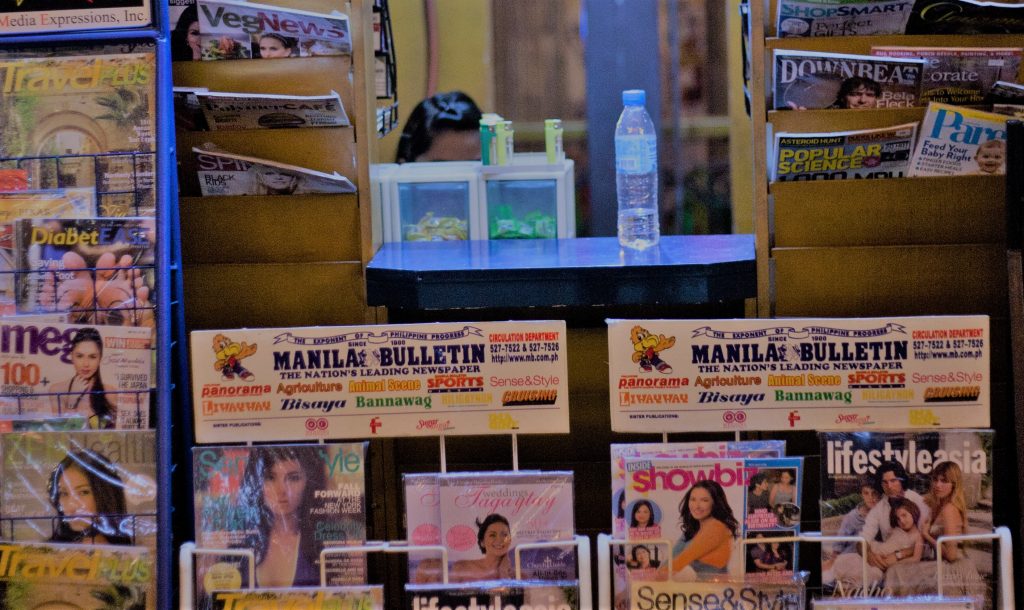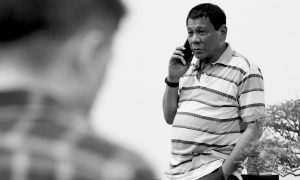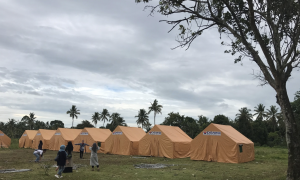“They will list my name in the dictionary someday. They will use Imeldific to mean ostentatious extravagance.”
This was a prediction widely believed to have been made by Imelda Marcos during the height of her power as First Lady of the Philippines. The second part of this prediction has certainly come true, as some Filipinos still use Mrs Marcos’ coinage to describe people who do not hesitate to flaunt their luxurious lifestyles. The first part, however, remains unfulfilled, as Imeldific is yet to make it into the world’s recognised dictionaries of English, Filipino, or any other language.
What Mrs Marcos may not be aware of is that although her first name is not in a dictionary as she predicted, her last name is. The word Marcosian is recorded in the Oxford English Dictionary (OED) as an adjective with the meaning “of, resembling, or characteristic of Ferdinand Marcos or his (authoritarian) rule.” The definition mentions only the name of her husband, but the etymology for the entry specifies that later uses of the word refer to Imelda—and the illustrative quotation that the OED cites from a 1997 Times article makes this more than obvious, with its allusion to the “Marcosian collection of shoes” for which Mrs Marcos is internationally known.
The Marcoses are hardly the first political figures to have made their mark on the English lexicon. The addition of suffixes such as –ian, –esque, –ite and -ista to the names of world leaders is a common way to form adjectives that can then be used to describe anything relating to these leaders and their politics—Rooseveltian, Reaganesque, Thatcherite, and Peronista are just a few examples from the last century.
Landmark political events can also lead to the creation of new words, with the Watergate scandal of 1972 being the prime example. The burglary in the Watergate building that eventually resulted in U.S. President Richard Nixon’s resignation became so engrained in the public consciousness that within a year of the incident, people began to detach –gate from the original word and attach it to other words to make names for all sorts of scandals and controversies, starting a lexical trend that shows no sign of abating 45 years after the fateful event that triggered it.
However, the impact of historical developments on our word stock goes beyond the invention of curious neologisms referring to specific people and events. The words that make up the vocabulary of a speech community are created as a response to the communicative needs of its members at any given time, needs that are largely determined by their social, cultural, and political environment.
We can learn so much about a people by studying the words they use, and in this sense, a dictionary—being an inventory of these words—becomes a key to understanding a community’s material and subjective culture. Particularly suited for this purpose is the OED, a dictionary containing information on the meaning, history, and pronunciation of over 600,000 English words, exemplified by nearly three million quotations taken from a wide variety of sources.
Generally regarded as the most authoritative and comprehensive record of the English language, the OED is more than just a book of definitions—it is also an incomparably rich resource that can provide insight not only on words, but also on the people who use them. This is especially true now that the digital, online format of the dictionary’s third and current edition has enabled its users to engage with its vast and varied content not only by looking at individual words, but also by uncovering and analysing patterns of word use. If lexical history is a reflection of general history, then the OED is a mirror that allows us to see this reflection with greater clarity and detail.
The OED’s value as a chronicle of Anglophone society can be demonstrated by focusing on its coverage of words from an emerging variety of English in Southeast Asia, Philippine English. Today, the Philippines is recognised as one of the world’s largest English-speaking countries. English continues to function as the nation’s language of business, science, technology, government, education, and international communication. It has a strong presence in local print and broadcast media, and a substantial body of creative literature.
The Filipino population’s English-language proficiency is the sustaining force of a booming outsourcing industry, as well as a rapidly growing education sector that is attracting increasing numbers of international students. In the Philippines, English co-exists with more than a hundred languages and dialects spoken throughout the country, creating a situation of close language contact that has given rise to a constantly evolving nativised vocabulary that differs significantly from the British or American standard. Further enriching the local lexicon are the varying periods of the Philippines’ long and turbulent history, each of which—from the country’s distant pre-Hispanic past to its centuries of Western colonisation to its most recent experience as an independent postcolonial nation—made a distinctive contribution to the Philippine English word store.
The oldest words of Philippine origin in the OED can be traced to the beginnings of the Spanish colonial era, with quotations for these words dating to as far back as the 16th, 17th, and 18th centuries. This early-stage vocabulary made its way into English hundreds of years before the language itself reached Philippine shores, mainly through navigational and geographical accounts of the islands, whether translated into English from Spanish originals, or written by the first Englishmen to travel to the region. Among them were the 17th-century navigator William Dampier, author of A New Voyage Round the World (1697), cited by the OED as the source of a number of first known examples of words from the New World. These works, as well as subsequent writings based on them, resulted in the importation into English of several exotic new terms pertaining to objects (e.g., caracore, a kind of boat; medrinaque, a type of cloth), plants (e.g., abaca, a kind of banana plant which yields a strong fibre), animals (e.g., calangay, a white parrot; colugo, a flying lemur), and ethnic groups and their languages (e.g., Bajau, Pampangan, Tagalog) that European explorers and colonisers encountered in the Philippines.
Although most of these early Philippine words in the OED are largely of scientific or anthropological interest, a few have become part of the everyday vocabulary of Philippine English speakers. One notable example is the word barangay. The barangay is the smallest administrative division in the Philippines, roughly equivalent to the concept of village, district, or ward. Barangay was adopted into Philippine English from Tagalog, the regional language on which the Philippine national language, Filipino, is based. The Tagalog term is derived from the Austronesian word balangay, which refers to a type of boat used by early Filipinos to travel across Southeast Asia from the 10th century. The original barangays were small coastal or riverine settlements consisting of 50 to 100 families, but some of them grew to become large, cosmopolitan principalities with trade links to their Asian neighbours. These pre-colonial societies were headed by an aristocratic class called datu or datuk, another pre-Hispanic Philippine term of Austronesian origin recorded by the OED.
With the arrival of the Spanish, barangays were combined to form towns, headed by a town chief called by the Spanish-Tagalog hybrid expression cabeza de barangay, still in use today. Barangay fell into disuse during the American period, when it was replaced by the Spanish term barrio, but it underwent a resurgence in the 1970s when former President Ferdinand Marcos ordered the restoration of the name barangay, and used the idealised vision of “baranganic democracy” in the participatory politics of his New Society. The word survived Marcos’ overthrow in the 1986 EDSA revolution, and endures today as an integral part of the Philippine political system. From a lexical perspective, barangay is extremely productive, giving rise to a range of familiar expressions: barangay captain (another name for cabeza de barangay), barangay officials, barangay tanod (unarmed watchmen that act as barangay police), barangay council, barangay hall, barangay clearance, and barangay elections.
By the 19th century a trend of lexical borrowing emerges, one that stems from the sociolinguistic divide during the Hispanic colonial period that saw Spanish being spoken by the ruling elite, while local languages were used by the lower classes. This is made apparent by the sources of words borrowed into Philippine English as recorded by the OED: those from Spanish are usually related to law, government, and administration (e.g., presidente, the chief official of a town or village; sala, a branch or division of a court of law, a courtroom), whereas those from Philippine languages pertain to the rural environment and beliefs of farmers and fisherfolk (e.g., anting-anting, “an amulet with the supernatural power of protecting its possessor from harm”; palay, “rice prior to husking”).
After 300 years of colonisation, Spain lost the Philippines to the United States following its defeat in the Spanish-American War of 1898. Filipinos declared independence in the same year, but after three years of armed resistance the nascent republic was overcome by the much stronger superpower, and in 1902 the Philippines officially became an unincorporated US territory.
The nation’s new rulers proceeded to introduce English as the primary language of government, business, and education, establishing a new English-medium public school system and sending American language teachers to the islands. Americans were so successful in their efforts to promote the use of English in the Philippines that within a few years, Filipino schoolchildren were learning it from non-native Filipino teachers, and by the 1920s home-grown Filipino writers had begun producing literary works in English. Within a couple of decades, English had become a Philippine language.
It is therefore unsurprising that, according to OED data, the influx of Philippine words into English reached a peak in the first half of the 20th century. Once again, a group of Western colonisers found themselves confronted by what to them was a strange new world, full of novel sights, concepts, and experiences that they had to name and describe. And just like the Spanish before them, the Americans did this by adapting existing words in their language, and by borrowing from native vernaculars such as Tagalog. Some of the most recognisable and widely used Philippine English words were first attested in written English during this period of American annexation: tabo, balut, bagoong, pancit, calamansi, sampaguita, sinigang. Indeed, the very words that signify Philippine identity—Filipino and its informal counterpart, Pinoy—were first used in English just as the Americans and their language took over the archipelago.
Spanish, despite being superseded by English as the prestige colonial language, maintained considerable influence, thanks to the many lexical footprints it left in Philippine languages that also found their way into Philippine English. Words of Spanish origin continued to stream into the English lexicon during the American period, especially in the semantic fields of cookery (adobo, leche flan, lechon, pan de sal, sorbetes) and governance (ladronism, poblacion). The word aggrupation is a particularly interesting example, as it is a Spanish loan that was absorbed directly into Philippine English without going through Tagalog first, as it is an Anglicisation of the Spanish word agrupación, which in Philippine politics is used to refer to a grouping or affiliation formed on the basis of common interests or objectives.
The road to independence that the United States promised the Philippines was interrupted by the outbreak of the Second World War and the Japanese invasion of the islands. It was only at the end of this long and bloody conflict that the Philippines finally became independent, and this new republic placed English at the centre of its project of nation-building by retaining the official status accorded to the language by the 1935 Constitution enacted during the American occupation. It is in this postcolonial era that we begin to see a new type of local vocabulary—borrowings and coinages that relate to concepts of native identity and express various aspects of everyday life in the Philippines.
The nature of the quotations that illustrate Philippine words in the OED also changed during these years. As more and more Filipinos became Anglophone speakers and writers themselves, dictionary quotations for Philippine English entries began to come from the pens of Filipino authors, whose various forms of writing provided the OED with evidence for entries beyond the typical flora and fauna words of the colonial period. The scope of the dictionary’s Philippine coverage expanded to include other semantic domains relevant to Filipino life and culture: from greetings (mabuhay); to indigenous sports (arnis); to items of traditional dress (barong or barong tagalog, baro’t saya), to kinship terms and terms of address (Aling/Mang, ate/kuya, lola/lolo, tita/tito, yaya), to archetypal Filipino traits and values (bahala na, bayanihan, utang na loob).
Philippine English continued to evolve throughout the various periods of the country’s postcolonial history. The tumultuous years of the Marcos dictatorship gave English not only the adjective Marcosian, but more notably a new meaning to the verb salvage, a word which, from 1980 on, has been used in the Philippines to mean, not to save, but to summarily execute a suspected criminal. This new, completely opposite sense is believed to be a euphemism coined by Filipino journalists to refer to the extrajudicial killings that characterised the Marcos regime.
With the restoration of democracy in the late 1980s came a new Philippine constitution that maintained the official status of English. The continued presence of the language in Philippine society gives Filipinos even more need and opportunity to make the English lexicon their own, using a wide range of strategies in the creation of new words. Among the new Philippine words from the past thirty years that have recently been added to the OED are the blended word teleserye (a soap opera, from tele- of television + serye Tagalog for “series”); the compound kikay kit (a cosmetic bag, from kikay, a Tagalog word for a stylishly feminine woman + bag); the initialism KKB (from Tagalog kaniya-kaniyang bayad, “each one pays their own”, indicating that the cost of a meal is to be shared); the derivation presidentiable (a presidential candidate, from president + able suffix); and the loanword kilig (from Tagalog, exhilaration or elation caused by an exciting or romantic experience).
This small selection of neologisms shows how Filipinos experiment with words, pulling them apart and putting them back together, mixing up elements from all the languages they have at their disposal, playing with meaning, function, and form to express different concepts. Perhaps one relatively young word that best captures this lexical creativity is trapo—a derogatory name for a politician perceived as belonging to a conventional and corrupt ruling class. The word fuses together the component words of the English phrase traditional politician, but the resulting blend is also the word for a dirty old rag, used in Tagalog and other Philippine languages, which itself comes from a Spanish word still in current use. This makes trapo not only a convenient contraction, but also a vivid, highly effective metaphor that likens a corrupt politician to a filthy, disposable scrap of cloth. As a word that combines influences from English, Spanish, and Philippine languages, it distils centuries of Philippine political, cultural, and linguistic history into five letters.
Language shaming in Malaysia
Tan Zi Hao takes a look at stammering tongues and postcolonial imperialism.
What then of Imeldific and Imelda Marcos’ bid to be immortalised in a dictionary? In the years since Mrs Marcos coined the word, Imeldific has been on a slow burn—quirky and memorable enough to stick in the minds of Philippine English speakers, and yet never having enough widespread relevance or currency to get on a lexicographer’s radar. It did seem that that was how things were going to stay, until this year, when a controversial display of wealth and privilege by a young member of the current Philippine president’s family reminded Filipinos of Imelda and her extravagant ways, putting the word back on everyone’s lips and social media feeds. This sudden twist may prove pivotal for Imeldific, as this spike in usage may just provide the right amount of contemporary evidence that can usher it into the pages of a dictionary. But just as with most words, Imeldific’s ultimate fate is something that history will decide.
 Facebook
Facebook  Twitter
Twitter  Soundcloud
Soundcloud  Youtube
Youtube  Rss
Rss 



